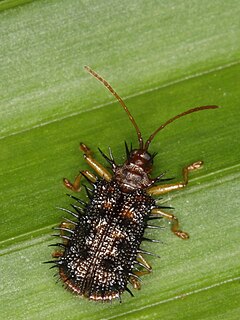
The insects of the beetle family Chrysomelidae are commonly known as leaf beetles, and include over 37,000 species in more than 2,500 genera, making up one of the largest and most commonly encountered of all beetle families. Numerous subfamilies are recognized, but the precise taxonomy and systematics are likely to change with ongoing research.

The tansy beetle is a species of leaf beetle. It measures 7.7–10.5 mm in length and has a characteristic bright metallic green colouration. The common name derives from the tansy plant on which they often feed as both larvae and adults. In addition to the nominotypical subspecies, which repeats the specific name, C. graminis graminis, there are five further distinct subspecies of tansy beetle, which, collectively, have a Palearctic distribution, although in the majority of countries where it is found the species is declining. In the United Kingdom it is designated as 'Nationally Rare' and this localised population, centred on York, North Yorkshire, has been the subject of much recent research.

Chrysochus cobaltinus, the cobalt milkweed beetle or blue milkweed beetle, is a member of the diverse family leaf beetles (Chrysomelidae). It occurs in the Western United States and British Columbia.

Chrysolina cerealis, the rainbow leaf beetle or Snowdon beetle, is a beetle belonging to the family Chrysomelidae.

Pachnoda marginata is a beetle from the subfamily Cetoniinae with a large number of subspecies that lives in west and central Africa. They are sometimes used as food for terrarium animals. The adult beetles are 20–30 mm, the larvae are very small when they hatch, but can grow as long as 60 mm. It is commonly called the sun beetle.

Xanthogaleruca luteola, commonly known as the elm-leaf beetle, is a beetle species in the family Chrysomelidae that is native to Europe but invasive in other parts of the world.

Galeruca tanaceti is a species of leaf beetle found in the Palearctic realm, and is the type species of the genus Galeruca. It was first described by Carl Linnaeus in his 1758 10th edition of Systema Naturae.

Chrysomela populi is a species of broad-shouldered leaf beetles belonging to the family Chrysomelidae, subfamily Chrysomelinae.

Clytra laeviuscula, the ant bag beetle, is a species of short-horned leaf beetles belonging to the family Chrysomelidae, subfamily Cryptocephalinae.

Cryptocephalus sericeus is a species of cylindrical leaf beetles of the family Chrysomelidae, subfamily Cryptocephalinae.

Exosoma lusitanicum or daffodil leaf beetle is a species of skeletonizing leaf beetles belonging to the family Chrysomelidae, subfamily Galerucinae.

Gonioctena fornicata is a species of broad-shouldered leaf beetles belonging to the family Chrysomelidae, subfamily Chrysomelinae.

Lilioceris merdigera is a species of beetle belonging to the family Chrysomelidae, subfamily Criocerinae.

Luperus longicornis is a skeletonizing leaf beetle belonging to the family Chrysomelidae, subfamily Galerucinae. The species was first described by Johan Christian Fabricius in 1758.

Arima is a genus of leaf beetles (Chrysomelidae) belonging to the subfamily Galerucinae. Species of this genus are found in France, on the Italian mainland, and in Sicily. They present clear sexual dimorphism, as females are generally much larger than males.

Vesperus luridus is a species of beetle in the Vesperidae family

Aspidimorpha sanctaecrucis, sometimes called the Golden Tortoise Beetle, is an Old World species of beetle belonging to the family Chrysomelidae.

Luperus flavipes is a species of skeletonizing leaf beetle belonging to the family Chrysomelidae, subfamily Galerucinae.

Dicladispa armigera is a species of leaf beetle from Southeast Asia, often known by its common name: the "rice hispa". These beetles are a well known invasive pest, and are responsible for significant crop damage across many countries. The male to female ratio is between 1:1.26 and 1:1.46.

Luperus viridipennis is a species of skeletonizing leaf beetle belonging to the family Chrysomelidae, subfamily Galerucinae.





















